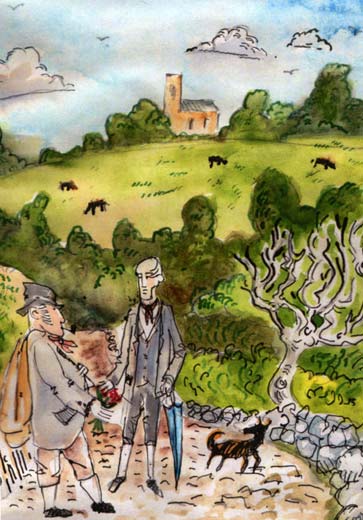History Society Report
The Artisan Naturalists
Speaker: Rob Trueblood
Wednesday, 29 March 2017
Hebden Bridge Local History Society heard an inspiring story of self-taught working men who became experts in their chosen field of Botany, when Rob Trueblood told the stories of some of these men from Lancashire and Yorkshire. They are known as the Artisan Naturalists.
The extent of their achievements is marked in the dedications inscribed on their tomb-stones and in memorials in churchyards from Prestwich to Todmorden that were erected to them by grateful and admiring local people. These were men of humble origin who clearly made their mark and were held in high esteem for their achievements.

John Horsefield and Richard Buxton meet up
John Horsefield was a handloom weaver from Whitefield who taught himself about botanical classification while sitting at his loom and memorising the complex Latin names and taxonomies of plants. Richard Buxton, a shoemaker, began by teaching himself to read from a spelling book before progressing to read the most complex technical books and become an expert in mosses. Buxton’s skill had practical applications – his employer sold herbal drinks and precise identification was crucial. Both these men, and others like them, operated at a high scientific level, drawing on the ‘taxonomies’ devised by Linnaeus.
Calder Valley's artisan naturalists
The Calder Valley too had its artisan naturalists who formed part of the network of keen and independent botanists. Samuel Gibson was a whitesmith (tin-worker) from Hebden Bridge who made a detailed account of the botany within a mile of Heptonstall and was especially knowledgeable about grasses and mosses. James Bolton of Warley used his artistic skills to draw and make copperplate etchings of fungi, while Todmorden’s John Nowell is himself memorialised in St Mary’s churchyard.
Meeting and publishing
These men from Lancashire and Yorkshire would meet, sometimes on ’botanizing’ field trips, and correspond. But what was even more significant was their passion to teach as well as to learn. They helped set up local botany societies, often meeting in local pubs, and charging a small subscription that enabled them to purchase the specialist books and equipment they needed. They also contributed to science by publishing books with meticulous descriptions of local flora and making extensive collections of plants. They are characterised by a precision in observing and recording what they encountered in the fields close to home.
The artisan naturalists are an inspiring example of that spirit of self-reliance and thirst for knowledge which we associate with the Enlightenment. They did not accept the limitations of their economic situation or even lack of education – they valued learning and were generous in their teaching and sharing of knowledge. Fittingly, a descendant of Samuel Gibson was one of the founders of Hebden Bridge Literary & Scientific Society and the Local History Society.
This was the last in the current lecture series, but you can keep in touch with other activities via the website and you can also follow us on our Facebook page.
With thanks to Sheila Graham for this report
See also


